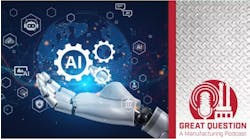Likewise, manufacturers have willingly embraced new sources of data at almost every turn. Now, in a happy intersection of adoption and maturation, just as the exploding world of smarter industrial technology is beginning to generate vastly more data about manufacturing activities, analytics and decision making is getting a boost.
Machine learning, a facet of information technology related to pattern recognition and artificial intelligence, is offering a tool for rapidly wading through vast quantities of data and generating new insights and control mechanisms. In essence, machine learning offers some of the capabilities of a human expert because it can sort through masses of information and draw new conclusions about what has happened or what is likely to happen and can even make decisions on that basis. However, it does this much faster and more reliably – and of course at less cost.
[callToAction]
For instance, a recent case study describes the success Rio Tinto found in finally tracking down a persistent and mystifying quality problem. The company manufactures metal powders used to make many kinds of components. With hundreds of data points on each type of powder, it had become difficult to discern causation when failures occurred. Traditional methods were at best slow to produce results. But a machine learning approach identified an issue involving incoming materials within just 45 minutes!
This is where it gets interesting. In addition to a range of specific “on premise” machine learning solutions on the market today, behemoths such as Microsoft and IBM are now offering comparatively easy-to-use, potent machine learning capabilities as a cloud-based service. For example, Microsoft Azure Machine Learning Studio provides an environment for connecting your data to lots of “smarts” in the cloud, allowing affordable predictive analytics, on demand. So far, there’s not much tailoring to meet the specific needs of manufacturers but that’s bound to happen. Likewise, the IBM Watson Developer Cloud provides a similar palette of cloud-based services for identifying and solving problems.
The cloud based options, combined with the wide range of on-premise choices, offer organizations more ways to apply machine learning within a budget. It’s a new frontier for optimizing operations and potentially discovering new and better ways of deploying resources.
Alan R. Earls is a Boston-based writer focused on technology, business, and manufacturing — a field where he spent the earliest part of his career. He has written for publications and websites as diverse as The Boston Globe, Computerworld and Modern Infrastructure as well as Industry, The Manufacturer, and Today's Machining World.
Photo Courtesy of Rio Tinto



